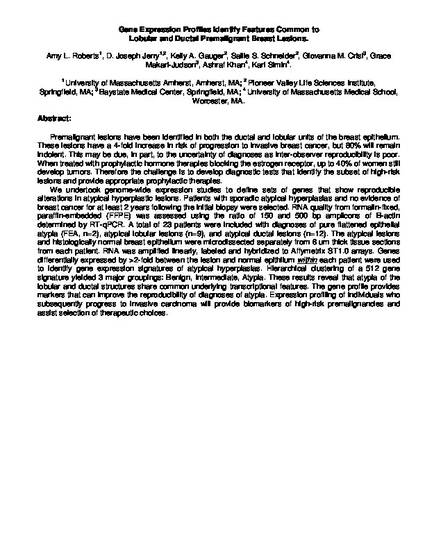
Premalignant lesions have been identified in both the ductal and lobular units of the breast epithelium. These lesions have a 4-fold increase in risk of progression to invasive breast cancer, but 80% will remain indolent. This may be due, in part, to the uncertainty of diagnoses as inter-observer reproducibility is poor. When treated with prophylactic hormone therapies blocking the estrogen receptor, up to 40% of women still develop tumors. Therefore the challenge is to develop diagnostic tests that identify the subset of high-risk lesions and provide appropriate prophylactic therapies. We undertook genome-wide expression studies to define sets of genes that show reproducible alterations in atypical hyperplastic lesions. Patients with sporadic atypical hyperplasias and no evidence of breast cancer for at least 2 years following the initial biopsy were selected. RNA quality from formalin-fixed, paraffin-embedded (FFPE) was assessed using the ratio of 150 and 500 bp amplicons of B-actin determined by RT-qPCR. A total of 23 patients were included with diagnoses of pure flattened epithelial atypia (FEA, n=2), atypical lobular lesions (n=9), and atypical ductal lesions (n=12). The atypical lesions and histologically normal breast epithelium were microdissected separately from 6 um thick tissue sections from each patient. RNA was amplified linearly, labeled and hybridized to Affymetrix ST1.0 arrays. Genes differentially expressed by >2-fold between the lesion and normal epithlium within each patient were used to identify gene expression signatures of atypical hyperplasias. Hierarchical clustering of a 512 gene signature yielded 3 major groupings: Benign, Intermediate, Atypia. These results reveal that atypia of the lobular and ductal structures share common underlying transcriptional features. The gene profile provides markers that can improve the reproducibility of diagnoses of atypia. Expression profiling of individuals who subsequently progress to invasive carcinoma will provide biomarkers of high-risk premalignancies and assist selection of therapeutic choices.
Available at: http://works.bepress.com/grace_makari-judson/24/

Abstract of poster presented at the 2014 UMass Center for Clinical and Translational Science Research Retreat, held on May 20, 2014 at the University of Massachusetts Medical School, Worcester, Mass.